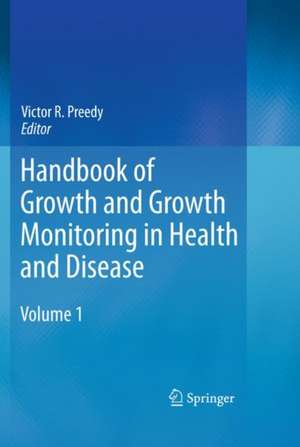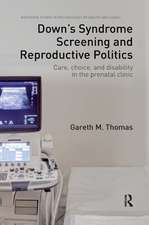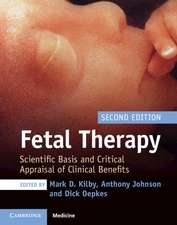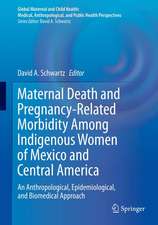Handbook of Growth and Growth Monitoring in Health and Disease
Editat de Victor R. Preedyen Limba Engleză Paperback – 22 aug 2016
| Toate formatele și edițiile | Preț | Express |
|---|---|---|
| Paperback (1) | 3606.23 lei 39-44 zile | |
| Springer – 22 aug 2016 | 3606.23 lei 39-44 zile | |
| Hardback (1) | 3728.03 lei 3-5 săpt. | |
| Springer – dec 2011 | 3728.03 lei 3-5 săpt. |
Preț: 3606.23 lei
Preț vechi: 3796.02 lei
-5% Nou
Puncte Express: 5409
Preț estimativ în valută:
690.06€ • 721.94$ • 573.23£
690.06€ • 721.94$ • 573.23£
Carte tipărită la comandă
Livrare economică 31 martie-05 aprilie
Preluare comenzi: 021 569.72.76
Specificații
ISBN-13: 9781493940806
ISBN-10: 1493940805
Pagini: 3164
Ilustrații: LVII, 3164 p. In 3 volumes, not available separately.
Dimensiuni: 178 x 254 mm
Greutate: 6.13 kg
Ediția:Softcover reprint of the original 1st ed. 2012
Editura: Springer
Colecția Springer
Locul publicării:New York, NY, United States
ISBN-10: 1493940805
Pagini: 3164
Ilustrații: LVII, 3164 p. In 3 volumes, not available separately.
Dimensiuni: 178 x 254 mm
Greutate: 6.13 kg
Ediția:Softcover reprint of the original 1st ed. 2012
Editura: Springer
Colecția Springer
Locul publicării:New York, NY, United States
Cuprins
SECTION 1. Low and very low birth weight infants.- 1. Development of thyroid function in very low birth weight infants.- 2. Growth after very low birth weights: Germany perspectives.- 3. First trimester fetal growth and low birth weight.- 4. Following up very low birth weight children to preschool age.- 5. Zinc and low birth weight.- 6. Early nutrition and very low birth weights infants.- 7. Aggressive nutritional strategy in very low birth weight infants: impact on growth.- 8. Visual development in very low birth weight infants.- 9. Visual ability in very low birth weight infants.- 10. Parental relationships with very low birth weight infants.- SECTION 2. Intrauterine growth retardation.- 11. Intrauterine growth standards.- 12. Risk factors for adverse outcomes in developing countries: role of interuterine growth retardation .- 13. Growth outcomes in intrauterine growth retardation: Australian perspectives.- 14. Neurodevelopment outcome of children with intrauterine growth retardation: A longitudinal, 10-year prospective study.- 15. Memory functions of children with intrauterine growth restriction.- 16. Intrauterine growth and intelligence.- 17. Drug exposure and intrauterine growth .-18. Intrauterine growth retardation and non-alcoholic fatty liver disease in children.- 19. Ultrasound brain lesions in intrauterine growth retardation .- 20. Intrauterine growth restriction and blood pressure.- 21. Treatment for Short stature after intrauterine growth retardation.- 22. Anthropometric parameters and intrauterine growth retardation: Togo perspectives .- SECTION 3. Preterm infants.- 23. Periodic breathing in term and preterm infants.- 24. The relationship between growth and perinatal factors in preterm infants.- 25. Growth curves for preterm infants.- 26. Development of oral feeding skills in the preterm infant.- 27. Growth factors and endocrine milieu in preterm and term infants.- 28. Protein metabolism in preterm infants: implications for growth.- 29. Birth weight standards, fetal growth, and preterm infants.- 30. Maturation and growth indices of the brain in preterm infants.- 31. The development of cerebral cortex in prematurely born infants.- 32. Development of motor coordination and attention in preterm infants and relation to intensive care.- 33. Inflammatory and growth mediators in the blood in preterm infants.- 34. Weight gain and linear growth in milk feeding in preterm infants.- 35. Brain volume in preterm infants.- 36. Impact of prematurity on school-age outcomes.- 37. Visual and visuocognitive development in children born very prematurely.- SECTION 4. Postnatal growth in normal and abnormal situations.- 38. Defects on long arm of chromosome 20 and postnatal growth retardation.- 39. Postnatal growth in HIV.- 40. Postnatal growth failure and Z score.- 41. Prediction of postnatal growth curves for premature infants.- 42. Adiposity during preweaning postnatal growth.- 43. Postnatal development in cleft palate.- 44. Blood pressure and postnatal growth in schoolchildren: World and Mexico perspectives.- 45. Hormonal regulation of postnatal growth in children.- 46. Postnatal growth and growth hormone.- 47. Postnatal weight increase and growth velocity of very low birth weight infants: Italian perspectives.- SECTION 5. Catch-up growth.- 48. Weight requirements for Catch-up growth in girls with eating disorders.- 49. Catch-up growth and corticosteroids.- 50. Thyroid function during Catch-up growth.- 51. Endocrine aspects of catch-up growth.- 52. Catch-up growth: Hertfordshire studies.- 53. Catch-up growth up to ten year olds: Dutch perspectives .- 54. Catch-up growth and supine length/height in preterm infants.- 55. Catch-down growth and short-statured parents.- 56. Adiposity and insulin resistance after catch-up growth.- 57. Catch-up and normal growth of children on long-term dialysis.- 58. Lung development in children and in catch-up growth.- 59. Catch-up growth in refugee children.- 60. Failure to achieve catch-up growth: Spanish studies.- 61. Catch-up growth: Mexico perspectives.- 62. Growth surveillance of those without catch-up.- 63. Serum adiponectin levels, insulin resistance, and lipid profile in catch-up and non-catch-up growth.- SECTION 6. Sexual maturation.- 64. Genital development in boys and testosterone levels.- 65. Pesticides and male genital growth.- 66. Pesticides and sexual development in girls.- 67. Disorders of breast growth.- 68. Sexual maturity in slums and rural areas.- 69. Breast development and the environment.- 70. Precocious puberty and growth of breast tissue.- 71. Gonadotropin-suppressive therapy and sexual growth.- 72. Sexual dimorphism and cortisol.- 73. Growth and sexual maturation in psychological disorders.- SECTION 7. Cells and growth of tissues.- 74. Growth and development of the brain.- 75. Growth and development of the kidney.- 76. Growth and development of the intestine.- 77. Growth and development of bone.- 78. Growth and development of muscle.- 79. Growth and development of liver.- 80. Growth and development of heart.- 81. Growth and development of dentofacial tissue.- SECTION 8. Sensory growth and development.- 82. Multisensory reweighting in children.- 83. Motor development in normal children and in disease.- 84. Speech and language development in normal children and in disease.- 85. Visual development.- 86. Development of hearing.- 87. Speech intelligibility development in hearing impaired.- 88. Development of the immune system.- SECTION 9. Country and regional aspects of growth and growth monitoring.- 89. Overview: Child development in developing countries.- 90. Rural versus urban growth in 47 developing countries.- 91. Effect of infant feeding on growth in 20 developing countries.- 92. Field-testing growth standards in different countries.- 93. Breast-feeding and growth in Lebanon.- 94. Features of normal and abnormal growth in India.- 95. Features of normal and abnormal growth in China.- 96. Features of normal and abnormal growth in Brazil.- 97. Features of normal and abnormal growth in Russia.- SECTION 10. Effects of disease on growth.- 98. Impaired bone mineral density in children with cerebral palsy.- 99. Growth in sickle cell disease.- 100. The NIH MRI study of normal brain development in the young.- 101. Minerals and growth: an example with zinc.- 102. Fetal alcohol exposure and infant growth.- 103. Iron deficiency anemia and infant growth.- 104. Growth in children with severe hemophilia.- 105. Growth in autism.- 106. Growth in Down syndrome.- 107. HIV-infected children and growth.- 108. Growth in short bowel syndrome (SBS) .- 109. Child growth and livelihood security.- 110. Growth in cerebral palsy.- 111. Growth in congenital heart disease.- SECTION 11. Exercise, sports, and growth.- 112. Elite sport practice in children: effects on growth.- 113. Effects of gymnastics on growth and pubertal maturation in young girls.- 114. Physical activity and bone growth and development in children .- 115. Child growth in physical activity skill development and dietary modification.- 116. The interaction of exercise, stress, and inflammation on growth.- 117. Growth hormone response to exercise.-118. Physical activity and bone growth.- 119. Infant mental development index.- SECTION 12. Endocrine Control and Regulation of Growth.- 120. Growth deceleration and corticosteroids.- 121. Leptin and ghrelin in growth.- 122. Insulin-like growth factor and growth.-123. Adiponectin and growth.- 124. Thyroid hormones and growth.- 125. Growth hormone and child growth .- 126. Growth hormone, Prader-Willi syndrome, and growth.- SECTION 13. Assessment of Growth.- 127. The 2006 WHO Child Growth Standards.- 128. WHO Child Growth Standards and the CDC 2000 growth charts.- 129. International growth standards for school-aged children and adolescents.- 130. Infant growth modeling and assessment of growth.- 131. Use of weight, height, and body mass index to indicate growth failure.- 132. Assessment of psychomotor development and growth.- 133. Growth and development in developing countries: what standards? .-134. Use of MRI to monitor brain growth.- 135. Neonatal screening methods.- 136. False positives and sensitivity in growth monitoring.- 137. Z scores: what they are and how to use them.- 138. Percentiles: what they are and how to use them.- 139. Growth velocity curves: what they are and how to use them.-140. Physical activity measured by accelerometry: completing growth evaluations
Notă biografică
Victor R. Preedy is currently Professor of Nutritional Biochemistry in the Department of Nutrition and Dietetics, King's College London and Honorary Professor of Clinical Biochemistry in the Department of Clinical Biochemistry, King's College Hospital. He is also Director of the Genomics Centre, Kings College London. He is presently a member of the School of Medicine, King’s College London. King’s College London is one of the leading universities, currently ranked consistently within the top 25 in the world. Professor Preedy gained his Ph.D. in 1981 and in 1992 he received his Membership of the Royal College of Pathologists (MRCPath), based on his published works. He was elected a Fellow of the Royal College of Pathologists (FRCPath) in 2000. In 1993 he gained his second doctorial degree (DSc) for his outstanding contribution to protein metabolism. In 2004 Professor Preedy was elected as a Fellow to both the Royal Society for the Promotion of Health (FRSH) and The Royal Institute of Public Health (FRIPHH). In 2009 he was elected as a Fellow of the Royal Society for Public Health (RSPH). He is also a Fellow of The Society of Biology (FSB). Professor Preedy has written or edited over 550 articles, which includes over 160 peer-reviewed manuscripts based on original research and 85 reviews and 30 books. His interests pertain to matters concerning nutrition and health at the individual and societal levels.
Textul de pe ultima copertă
Growth is one of the human body’s most intricate processes: each body part or region has its own unique growth patterns. Yet at the individual and population levels, growth patterns are sensitive to adverse conditions, genetic predispositions, and environmental changes. And despite the body’s capacity to compensate for these developmental setbacks, the effects may be far-reaching, even life-long. The Handbook of Growth and Growth Monitoring in Health and Disease brings this significant and complex field together in one comprehensive volume: impact of adverse variables on growth patterns; issues at different stages of prenatal development, childhood, and adolescence; aspects of catch-up growth, endocrine regulation, and sexual maturation; screening and assessment methods; and international perspectives. Tables and diagrams, applications to other areas of health and disease, and summary points help make the information easier to retain. Together, over 180 self-contained chapters in 15 sections cover every area of human growth, including:
The Handbook of Growth and Growth Monitoring in Health and Disease is an invaluable addition to the reference libraries of a wide range of health professionals, among them health scientists, physicians, physiologists, nutritionists, dieticians, nurses, public health researchers, epidemiologists, exercise physiologists, and physical therapists. It is also useful to college-level students and faculty in the health disciplines, and to policymakers and health economists.
- Intrauterine growth retardation.
- Postnatal growth in normal and abnormal situations.
- Cells and growth of tissues.
- Sensory growth and development.
- Effects of disease on growth.
- Methods and standards for assessment of growth, and more.
The Handbook of Growth and Growth Monitoring in Health and Disease is an invaluable addition to the reference libraries of a wide range of health professionals, among them health scientists, physicians, physiologists, nutritionists, dieticians, nurses, public health researchers, epidemiologists, exercise physiologists, and physical therapists. It is also useful to college-level students and faculty in the health disciplines, and to policymakers and health economists.
Caracteristici
Authors are international experts from leading institutions.
Experienced editor from one of the foremost health divisions and hospitals in the UK.
Each chapter includes applications to other areas of health and disease; practical methods and techniques, summary points, and/or key features.
Everything you need to know about normal and abnormal growth in health and disease at the cellular, tissue, organ and whole-organism level.
Includes supplementary material: sn.pub/extras
Experienced editor from one of the foremost health divisions and hospitals in the UK.
Each chapter includes applications to other areas of health and disease; practical methods and techniques, summary points, and/or key features.
Everything you need to know about normal and abnormal growth in health and disease at the cellular, tissue, organ and whole-organism level.
Includes supplementary material: sn.pub/extras
























